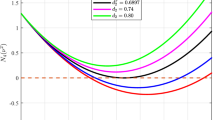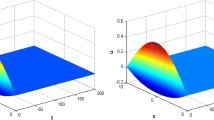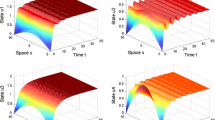Abstract
In this paper, a model for a network of neurons with reaction–diffusion is investigated. By analyzing the linear stability of the system, Hopf bifurcation and Turing unstable conditions are obtained. Based on this, standard multiple-scale analysis is used for deriving the amplitude equations of the model for the excited modes in the Turing bifurcation. Moreover, the stability of different patterns is also determined. The obtained results enrich the dynamics of neurons’ network system.













Similar content being viewed by others
References
Chua, L., Yang, L.: Cellular neural networks: theory. IEEE Trans. Biomed. Circuits Syst. 35, 1257–1272 (1988)
Chua, L., Yang, L.: Cellular neural networks: applications. IEEE Trans. Biomed. Circuits Syst. 35, 1273–1290 (1988)
Liu, Y., Wang, Z., Member, S., Liang, J., Liu, X.: Stability and synchronization of discrete-time Markovian jumping neural networks with mixed mode-dependent time delays. IEEE Trans. Neural Netw. 20, 1102–1116 (2009)
Yang, Z., Xu, D.: Stability analysis of delay neural networks with impulsive effects. IEEE Trans. Circuits Syst. 52, 517–521 (2005)
Yu, W., Cao, J., Chen, G.: Stability and Hopf bifurcation of a general delayed recurrent neural network. IEEE Trans. Neural Netw. 19, 845–854 (2008)
Forti, M., Tesi, A.: New conditions for global stability of neural networks with application to linear and quadratic programming problems. IEEE Trans. Biomed. Circuits Syst. 42(7), 354–366 (1995)
Huang, T., Li, C.D., Duan, S.K., Starzyk, J.A., Louvieris, P.: Robust exponential stability of uncertain delayed neural networks with stochastic perturbation and impulse effects. IEEE Trans. Neural Netw. 23, 866–875 (2012)
Cao, J., Xiao, M.: Stability and Hopf bifurcation in a simplified BAM neural network with two time delays. IEEE Trans. Neural Netw. 18, 416–430 (2007)
Xu, D., Zhao, H.: Invariant and attracting sets of Hopfield neural networks with delay. Int. J. Inf. Syst. Sci. 32(7), 863–866 (2001)
Chen, T., Wang, L.: Global-stability of delayed neural networks with unbounded time-varying delays. IEEE Trans. Neural Netw. 18, 1836–1840 (2007)
Zhao, H.: Global stability of bidirectional associative memory neural networks with distributed delays. Phys. Lett. A 297, 182–190 (2002)
Wang, L., Xu, D.: Global exponential stability of Hopfield reaction–diffusion neural networks with time-varying delays. Sci. China, Ser. F 46, 466–474 (2003)
Zhao, H., Wang, K.: Dynamical behaviors of Cohen–Grossberg neural networks with delays and reaction–diffusion terms. Neurocomputing 70, 536–543 (2006)
Qiu, J.: Exponential stability of impulsive neural networks with time-varying delays and reaction–diffusion terms. Neurocomputing 70, 1102–1108 (2007)
Wang, L.: Global exponential robust stability of reaction–diffusion interval neural networks with time-varying delays. Phys. Lett. A 350, 342–348 (2006)
Liang, J., Cao, J.D.: Global exponential stability of reaction–diffusion recurrent neural networks with time-varying delays. Phys. Lett. A 34, 434–442 (2003)
Turing, A.M.: The chemical basis of morphogenesis. Philos. Trans. R. Soc. Lond. B, Biol. Sci. 237, 37–72 (1952)
Zhang, X., Sun, G., Jin, Z.: Spatial dynamics in a predator–prey model with Beddington–DeAngelis functional response. Phys. Rev. E 85, 021924 (2012)
Liao, X., Li, J.: Stability in Gilpin–Ayala competition models with diffusion. Nonlinear Anal. 28(10), 1751–1758 (1997)
Xue, L.: Pattern formation in a predator–prey model with spatial effect. Physica A (2012). doi:10.1016/j.physa
Ou, Y.: Pattern Formation in Reaction–Diffusion Systems. Shanghai Sci-Tech Education Publishing House, Shanghai (2000)
Wang, W., Lin, Y., Zhang, L., Rao, F., Tan, Y.: Complex patterns in a predator–prey model with self and cross-diffusion. Commun. Nonlinear Sci. Numer. Simul. 16, 2006–2015 (2011)
Vogels, T., Rajan, K., Abbott, L.: Neural network dynamics. Annu. Rev. Neurosci. 28, 76–357 (2005)
Goras, L., Leenaters, D.: Turing patterns in CNNS. Part I. Once over lightly. IEEE Trans. Circuits Syst. 42, 602–611 (1995)
Goras, L., Chua, L.O.: Turing patterns in CNNs. II. Equations and behaviors. IEEE Trans. Circuits Syst. 42, 612–626 (1995)
Goras, L., Chua, L., Pivka, L.: Turing patterns in CNNs. III. Computer simulation results. IEEE Trans. Circuits Syst. 42, 627–637 (1995)
Wang, L., Zhao, H.Y., Hu, W.: Bifurcation and Turing instability of a class of reaction–diffusion neural networks. In: IEEE Fifth International Conference on Advanced Computational Intelligence, Nanjing, China, pp. 976–982 (2012)
Ott, E., Grebogi, C., Yorke, J.A.: Controlling chaos. Phys. Rev. E, Stat. Nonlinear Soft Matter Phys. 64, 1196–1199 (1990)
Zhao, H.Y., Yuan, J.L., Hu, W.: Time-delay control of stability and Turing pattern structures of neural networks. IET Control Theory Appl. 30, 288–298 (2013) (in Chinese)
Acknowledgements
We would like to express our gratitude to the referee for his or her valuable comments and suggestions that led to truly significant improvement of the manuscript. This research is supported by the National Natural Science Foundation of China (Nos. 61174155 and 11032009). The work is also sponsored by Qing Lan Project of Jiangsu.
Author information
Authors and Affiliations
Corresponding author
Rights and permissions
About this article
Cite this article
Zhao, H., Huang, X. & Zhang, X. Turing instability and pattern formation of neural networks with reaction–diffusion terms. Nonlinear Dyn 76, 115–124 (2014). https://doi.org/10.1007/s11071-013-1114-2
Received:
Accepted:
Published:
Issue Date:
DOI: https://doi.org/10.1007/s11071-013-1114-2




